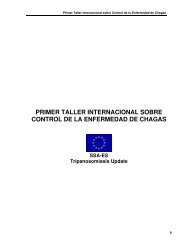El uso de Sistemas de Información Geográfica - CDIA-EC ...
El uso de Sistemas de Información Geográfica - CDIA-EC ...
El uso de Sistemas de Información Geográfica - CDIA-EC ...
Create successful ePaper yourself
Turn your PDF publications into a flip-book with our unique Google optimized e-Paper software.
<strong>El</strong> <strong>uso</strong> <strong>de</strong> <strong>Sistemas</strong> <strong>de</strong> <strong>Información</strong> Geografica y Sensores Remotos (SR) en Salud Pública<br />
Bogotá, Colombia, 27 al 30 <strong>de</strong> Marzo <strong>de</strong> 2006<br />
surveys have shown family and professional clusters of chronic Chagas disease.<br />
There is evi<strong>de</strong>nce of adaptation or pre-adaptation of triatomines: Rhodnius prolixus<br />
in Colombia and Venezuela, Panstrongylus geniculatus isolated foci in Brazil,<br />
Panstrongylus herreri increasingly adapted to houses in Peru, Triatoma maculata in<br />
Brazil, Colombia and Venezuela, and Triatoma rubrofasciata in port areas (Dias et<br />
al 2002). A surveillance system to evaluate the “state of art” and proposal<br />
measures to control and to avoid dispersion of Chagas disease in the Amazon<br />
region are urgently nee<strong>de</strong>d. We know very little about Chagas disease in the Pan-<br />
Amazon world. Our current knowledge is fragmentary and incomplete.<br />
In the Brazilian Amazon at least 16 species of triatomines 10 of them infected with<br />
T. cruzi have been <strong>de</strong>scribed: 1) Belminus herreri, 2) Cavernicola lenti, 3)<br />
Cavernicola pilosa, 4) Eratyrus mucronatus (+), 5) Microtriatoma trinida<strong>de</strong>nsis (+),<br />
6) Panstrongylus geniculatus (+), 7) Panstrongylus lignarius (+), 8) Panstrongylus<br />
rufoturberculatus (+), 9) Rhodnius brethesi (+), 10) Rhodnius nasutus, 11)<br />
Rhodnius neglectus (+), 12) Rhodnius paraensis (+), 13) Rhodnius pictipes (+), 14)<br />
Rhodnius robustus (+), 15) Triatoma maculata, 16) Triatoma rubrofasciata<br />
(Junqueira et al 2005).<br />
The studies of our group in the district of Barcelos, Amazon State, in Brazil, have<br />
confirmed in three conglomerate family samples seroepi<strong>de</strong>miological surveys, 2.8<br />
to 5.0% of T. cruzi infection. During the last survey 62.0% of the population<br />
recognized Rhodnius brethesi as the local vector and there was a positive<br />
correlation between seroposivity for T. cruzi infection with people bitten by this bug<br />
(Coura et al 2002b).<br />
A serological and parasitological study of people heavily exposed to triatomine<br />
bites in the district of Barcelos, Amazon State, in Brazil showed 11.0% of<br />
seropositives for T. cruzi infection, 19.5% of them had positive xenodiagnosis and<br />
PCR results for this parasite. The T. cruzi circulating in the area are Z1 (T. cruzi I),<br />
Z3 and one hybrid Z3/Z1. No T. cruzi II (domestic) was <strong>de</strong>tected. In this area we<br />
<strong>de</strong>scribed three typical cases of chronic Chagas cardiomyopaty and two other fatal<br />
cases of dilated Chagas disease cardiomyopathy.<br />
32




